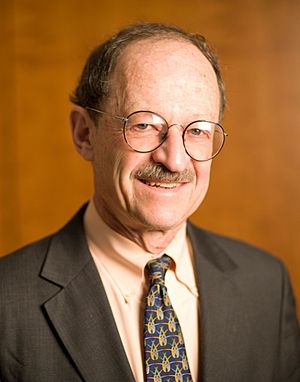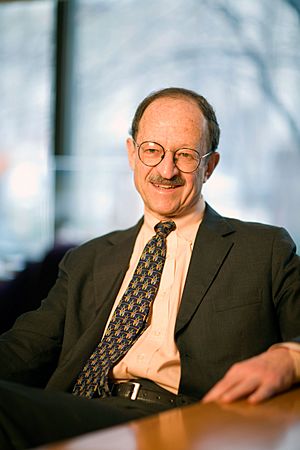Harold E. Varmus facts for kids
Quick facts for kids
Harold E. Varmus
|
|
|---|---|

Varmus in 2009
|
|
| 14th Director of the National Cancer Institute | |
| In office 2010–2015 |
|
| President | Barack Obama |
| Preceded by | John E. Niederhuber |
| Succeeded by | Douglas R. Lowy (Acting) Norman Sharpless |
| 14th Director of the National Institutes of Health | |
| In office November 23, 1993 – December 31, 1999 |
|
| President | Bill Clinton |
| Preceded by | Bernadine Healy |
| Succeeded by | Elias Zerhouni |
| Personal details | |
| Born |
Harold Eliot Varmus
December 18, 1939 Oceanside, New York, U.S |
| Spouse |
Constance Louise Casey
(m. 1969) |
| Children | 2 |
| Education |
|
| Known for |
|
| Awards |
|
| Scientific career | |
| Fields | Cancer biology |
| Institutions |
|
| Doctoral students | Kirsten Bibbins-Domingo Tyler Jacks |
Harold Eliot Varmus (born December 18, 1939) is an American scientist who won the Nobel Prize. He is currently a professor of medicine at Weill Cornell Medicine. He is also a senior associate at the New York Genome Center.
In 1989, he shared the Nobel Prize in Physiology or Medicine with J. Michael Bishop. They won for finding out where retroviral oncogenes come from in cells. Oncogenes are genes that can cause cancer. Varmus also led the National Institutes of Health from 1993 to 1999. Later, President Barack Obama chose him to be the 14th Director of the National Cancer Institute from 2010 to 2015.
Contents
Early Life and Education
Harold Varmus was born on December 18, 1939, in Oceanside, New York. His mother, Beatrice, was a social worker, and his father, Frank, was a doctor. He finished Freeport High School in 1957.
He first went to Amherst College planning to become a doctor like his father. But he ended up earning a bachelor's degree in English literature. In 1962, he got a master's degree in English from Harvard University. After that, he decided to apply to medical schools. He joined the Columbia University College of Physicians and Surgeons that same year.
Varmus worked at a hospital in Bareilly, India, and at the Columbia Presbyterian Medical Center. In 1968, he joined the Public Health Service at the National Institutes of Health. There, he studied how genes in bacteria work. In 1970, he started more research with J. Michael Bishop at the University of California, San Francisco.
Scientific Discoveries and Career
From 1968 to 1970, Varmus worked at the National Institutes of Health. He studied how certain genes in bacteria are controlled. In 1970, he moved to San Francisco and began working with J. Michael Bishop at the University of California, San Francisco (UCSF). He became a professor at UCSF in 1972.
For many years at UCSF, Varmus focused on how retroviruses copy themselves. He also studied how they cause cancer in animals and change cells. He worked closely with Michael Bishop on much of this research.
Nobel Prize-Winning Work
Their most famous discovery was finding a normal cell gene called c-Src. This gene was similar to a cancer-causing gene (v-Src) found in a virus called Rous sarcoma virus. This virus was first found in a chicken tumor in 1910. Their discovery helped scientists find many other normal genes, called proto-oncogenes. These proto-oncogenes can turn into cancer-causing genes if they get damaged or changed. Varmus's Nobel lecture and his book The Art and Politics of Science explain more about this important work.
Other Key Research
Over the years, Varmus also made other important discoveries. He helped explain how retroviral DNA is made and added to chromosomes. He found the Proto-oncogene Wnt-1 with Roel Nusse. He also studied how the hepatitis B virus copies itself. With Tyler Jacks, he discovered how retroviral proteins are made. His work also included finding a cell receptor for bird retroviruses. He studied changes in the epidermal growth factor receptor gene in human lung cancers. This included a common change that makes some cancer drugs not work as well. He also created many mouse models to study human cancer. Even when he held leadership jobs, Varmus continued to do or guide laboratory research.
Government Service and Leadership
In the early 1990s, after winning the Nobel Prize, Varmus became involved in science policy. He worked with other scientists to support scientific research. He also helped with the presidential campaign of Clinton-Gore in 1992.
Leading the National Institutes of Health
In 1993, President Bill Clinton chose Varmus to be the Director of the National Institutes of Health (NIH). He was confirmed by the Senate in November of that year. As NIH director, Varmus helped almost double the agency's budget for research. He also appointed excellent scientists to lead different institutes. He worked well with Congress and the government. He led important research on diseases like AIDS. He also helped create policies about stem cell research, cloning, and gene therapy. He promoted global health research, especially for malaria. During his time, new buildings were constructed at the NIH, including a new Clinical Center.
Between Leadership Roles
Varmus supported Al Gore in 2000 and John Kerry in 2004 for president. During the George W. Bush presidency, he spoke about his concerns regarding the government's science policies. However, he also praised PEPFAR (the President's Emergency Plan For AIDS Relief). This was a program started by Bush to fight AIDS around the world.
In 2008, Varmus supported Barack Obama for president. He led Obama's Science and Technology Committee. After Obama was elected, he was named a co-chair of PCAST (the President's Council of Advisors on Science and Technology). He left this role to become the Director of the National Cancer Institute (NCI) on July 12, 2010.
Leading the National Cancer Institute
On May 17, 2010, the White House announced that Varmus would be the 14th Director of the NCI. He was the first person to lead a single NIH Institute after leading the entire NIH. Even with less money for research, he started new centers for cancer genomics and global health. He also began new grant programs for "outstanding investigators" and for "Provocative Questions." He also renamed the Frederick National Laboratory for Cancer Research. He started a project there to study RAS oncogenes, which are genes that can cause cancer.
On March 4, 2015, Varmus resigned from the NCI. He returned to New York City to be a professor at Weill Cornell Medicine. He also became a senior associate at the New York Genome Center. Douglas Lowy became the acting director of the NCI on April 1, 2015.
While at NCI, Varmus wrote an essay with other scientists. It criticized some common practices in biomedical research. This essay led to efforts to make research less competitive.
Leading Memorial Sloan Kettering Cancer Center
After leaving the NIH in 1999, Varmus became the president and CEO of Memorial Sloan Kettering Cancer Center (MSKCC) in New York City on January 1, 2000. During his ten and a half years at MSKCC, he expanded the research staff. He also built a large new laboratory facility. He started a new graduate school for cancer biology. He oversaw the renovation of many clinics and led a major fundraising effort. He also continued to run his own lab and teach. On January 12, 2010, MSKCC announced that Varmus had asked them to find his replacement. He left MSKCC on June 30, 2010, before starting his role at the NCI.
Improving Science Publications
Towards the end of his time as NIH director, Varmus became a strong supporter of using the Internet to make scientific papers easier to access. He helped create PubMed Central with David Lipman. This is a public online library of full scientific reports. In 2007, Congress said that all research funded by the NIH must be available in PubMed Central within a year. Varmus also co-founded the Public Library of Science (PLOS). This is a non-profit group that publishes open-access journals in biomedical sciences.
Advisory Roles
Varmus has often advised the U.S. government, foundations, universities, and companies. He is currently on several important boards. These include the Secretary of Energy's advisory board and the Global Health Advisory Board at the Bill and Melinda Gates Foundation. He also advises the Lasker Foundation Prize Jury and the Scientific Advisory Board of the Broad Institute. He leads advisory groups for the Faculty of 1000 and the Global Alliance for Genomics and Health. Since 2021, he has chaired the World Health Organization's Science Council.
Varmus has spoken out about the high cost of many modern cancer drugs. He believes these costs make it hard for people to get treatment. He supports routine genetic testing for cancers. He thinks this information should be used more widely. He argues that using panel tests and exome analyses to find cancer-causing changes would be simpler and cheaper than full genome analysis. He believes these services should be covered by health insurance programs like Medicare and Medicaid. He also supports creating a database of information that can be linked to patient outcomes. This database would help all cancer doctors. He hopes researchers will soon study how cancer starts and how it spreads, known as metastatic cancers.
Awards and Honors
- 1975: Elected to the American Academy of Arts and Sciences
- 1982: Albert Lasker Award for Basic Medical Research
- 1984: Alfred P. Sloan, Jr. Prize
- 1989: Nobel Prize in Physiology or Medicine
- 1990: Golden Plate Award of the American Academy of Achievement
- 1994: Elected to the American Philosophical Society
- 2002: Novartis-Drew Award
- 2005: Elected a Foreign Member of the Royal Society (ForMemRS)
- 2008: Henry G. Friesen International Prize in Health Research
- 2011: Double Helix Medal
- 2012: Glenn T. Seaborg Medal
Personal Life
Harold Varmus married Constance Louise Casey in 1969. She is a journalist and science writer. They live in New York City and have two sons. Their son Jacob is a jazz trumpet player and composer. Their son Christopher is a social worker. Varmus and Jacob have performed "Genes and Jazz" lecture-concerts at various museums and centers.
See also
 In Spanish: Harold E. Varmus para niños
In Spanish: Harold E. Varmus para niños
- List of Jewish Nobel laureates



